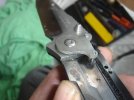Agreed, I was in the calibration field for a couple of years. Those kinds of tolerances are hard to obtain for a price any of us would consider and any slight bump or weather/environmental change would render the knife almost useless. Those kinds of tolerances are seen in laboratory settings where almost every variable is controlled, even to the point of radio frequencies being blocked out. Humidity and temperature has to be controlled to a very exact range,
That's if we're only talking about the mechanics being that tight. If they somehow have a lab set up and make the grinds to that level of accuracy, then I guess it could be done if the company was willing to constantly finely adjust, and I mean constantly, the settings. They'd also need to constantly recalibrate each machine to ensure tolerances were met, which most of the time it's not that simple. Also, given the fact that an absolute number was given instead of a range, that leads me to suspect some loose words were said.
For whatever it's worth, I worked in a type 3 calibration laboratory, with some specialists working in the same small building as me in type 2 labs. For those of you unfamiliar, there's only one type 1 lab in the country last time I was in the know, and that's NIST, the national institution of standards technology (the people who define what a inch means, or a second, or a gram, or any other unit of measure) and a handful of type 2 labs, which are only slightly less capable than a type 1. They could make something to those specs, but it'd come at a lot higher price than 500 or 1000 bucks. The amount of work that goes into creating a level surface that accurate is not easily done in any setting. If it's true, then awesome, but they'd need to show the calibration reports on machines that are known to NIST (or the Japanese equivalent vis a vis Rockstead) to be able to prove such statements.

